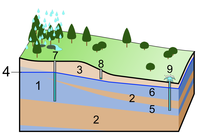
Photo from wikipedia
An investigation is presented to improve on the performances of the Basic DRASTIC Framework (BDF) and its variation by the Fuzzy-Catastrophe Framework (FCF), both of which provide an estimate of… Click to show full abstract
An investigation is presented to improve on the performances of the Basic DRASTIC Framework (BDF) and its variation by the Fuzzy-Catastrophe Framework (FCF), both of which provide an estimate of intrinsic aquifer vulnerabilities to anthropogenic contamination. BDF prescribes rates and weights for 7 data layers but FCF is an unsupervised learning framework based on a multicriteria decision theory by integrating fuzzy membership function and catastrophe theory. The challenges in the paper include: (i) the study area comprises confined and unconfined aquifers and (ii) Artificial Intelligence (AI) is used to run Multiple Framework (AIMF) in order to map specific vulnerability due to a specific contaminant. Predicted results by AIMF are referred to as Specific Vulnerability Indices, as the learned VIs are referenced to site-specific nitrate-N. The results show that correlation coefficient between BDF or FCF with nitrate-N is lower than 0.7 but the AIMF strategy improves it to greater than 0.95. The results are evidence for the proof-of-concept for transforming frameworks to models capable of further learning.
Journal Title: Journal of environmental management
Year Published: 2018
Link to full text (if available)
Share on Social Media: Sign Up to like & get
recommendations!